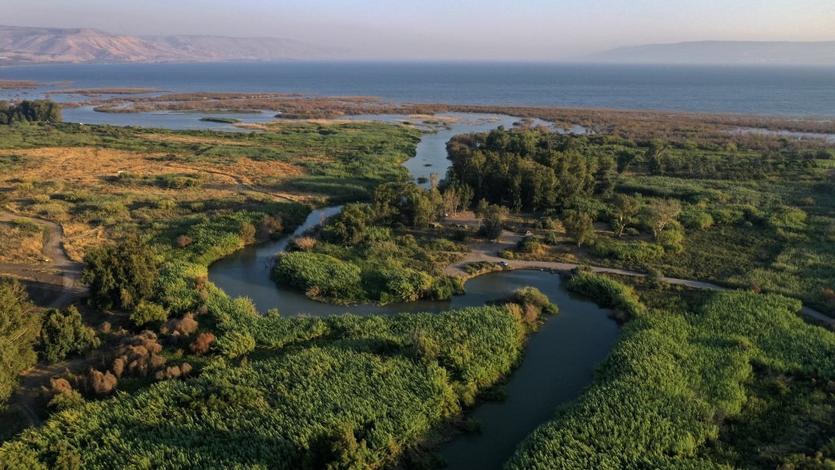 An aerial picture taken on July 15, 2021 shows the Jordan river flowing through the Beteha (Bethsaida Valley) into the northern part of the Sea of Galilee, or Lake Tiberias, one of the main water sources in Israel. (PHOTO / AFP)
An aerial picture taken on July 15, 2021 shows the Jordan river flowing through the Beteha (Bethsaida Valley) into the northern part of the Sea of Galilee, or Lake Tiberias, one of the main water sources in Israel. (PHOTO / AFP)
TIBERIAS — When the floodgates are open, a torrent of water gushes into a dry river bed and races to the shore of the Sea of Galilee, a biblical lake in northern Israel that was being lost to drought and the growing population around it.
The water is fresh, high-quality, expensive. Desalinated from the Mediterranean Sea and transported across the country where it awaits the order to replenish the lake should it start to shrink again.
Israel built a chain of desalination plants along its Mediterranean coast putting it in the unlikely position of having a surplus of water, a bright spot in an arid region extremely vulnerable to climate change
This new network will also let Israel double the amount of water it sells to neighbouring Jordan under a broader water-for-energy deal forged through a working, though often fractious, relationship.
READ MORE: Jordan's king says Palestinians must join regional projects
The Sea of Galilee, whose waters Christians believe Jesus walked upon, is Israel's main reservoir and a big tourist draw. Hotels and campsites line the perimeter encircled by lush hills. It feeds the Jordan River that flows south to the Dead Sea.
After a heat wave or a strong rain, the level of the lake makes national news. Alarms went off regularly this past decade following protracted droughts and receding shorelines.
So Israel built a chain of desalination plants along its Mediterranean coast putting it in the unlikely position of having a surplus of water, a bright spot in an arid region extremely vulnerable to climate change.
"All the extra water that (the plants) are producing, we will be able to bring it with the national water carrier system up north and into the Sea of Galilee," said Yoav Barkay, who manages the national carrier at state-owned Mekorot.
He stood at a collection pool above the lake on a dry, sunny day in late January that felt like spring rather than winter.
"With this environment of climate changes, you don't know what to expect next year and the year afterward," he said. "We are no longer depending on rain basically for water supply."
Water and peace
The refill system may be used more frequently with water exports to Jordan on the rise, he said. It can raise the lake's level by half a metre each year, according to Mekorot.
 In the photo taken on June 24, 2022, participants in a "Pride" flotilla row a kayak in the Sea of Galilee in northern Israel to mark the International Pride Month. (PHOTO / AFP)
In the photo taken on June 24, 2022, participants in a "Pride" flotilla row a kayak in the Sea of Galilee in northern Israel to mark the International Pride Month. (PHOTO / AFP)
Water was a major component in the peace treaty the neighbours signed in 1994. The arrangement was for Israel to supply Jordan with 50 million cubic meters of drinkable water a year. That was doubled in late 2021.
Both countries are active participants in the pact, even as they accuse each other of exacerbating the broader problem of water shortages through the management of their shared and connected rivers.
Jordanian and Israeli officials have traded blame over river levels, reservoirs and the progress of a separate scheme to desalinate water from the southern Red Sea - all potentially highly charged issues in a tense region where water is scarce.
 In the photo taken on Mar 16, 2022, a group of men work on the construction of a new pipeline by Israel's national water company near Kibbutz Ravid, west of Sea of Galilee. (PHOTO / AFP)
In the photo taken on Mar 16, 2022, a group of men work on the construction of a new pipeline by Israel's national water company near Kibbutz Ravid, west of Sea of Galilee. (PHOTO / AFP)
But there has been progress.
Around a year ago Israel and Jordan agreed to partner in a project that would see Jordan build 600 megawatts of solar generating capacity to be exported to Israel in return for the additional water supply.
Jordan’s minister of water and irrigation at the time said that climate change and an influx of refugees exacerbated Jordan’s water challenges, but that there are opportunities for regional cooperation to solve it.
Construction is now underway on a pipeline to again double the amount that will reach Jordan, industry officials told Reuters.
That means some 200 million cubic metres of water - the same amount consumed by the five biggest cities in Israel combined - will be supplied to Jordan.
READ MORE: Israel, Jordan sign deal allowing use of each other's airspace
The national water carrier is empty at the moment, undergoing seasonal repairs and upgrades. At one junction in northern Israel, engineers work on a pipe more than large enough for them to stand inside.
 The photo taken on Nov 10, 2021 shows Issa Kassissieh, better known as the Santa Claus of Jerusalem, paddle with a Christmas tree at the Sea of Galilee. (PHOTO / AFP)
The photo taken on Nov 10, 2021 shows Issa Kassissieh, better known as the Santa Claus of Jerusalem, paddle with a Christmas tree at the Sea of Galilee. (PHOTO / AFP)
They are adding a new line that jets off to the city Beit Shean and from there east to the Jordan border. Mekorot hopes to complete it in 2026.
The US Agency for International Development, which partners with Jordan in water security, says it is one of the most water-scarce countries in the world, with renewable water supply meeting around two-thirds of demand and groundwater being used twice as quickly as it can be replenished.


